
In the rapidly evolving landscape of modern warfare, two technologies stand out for their transformative impact: drone warfare and cyber warfare. Both have fundamentally changed the dynamics of conflict, shifting the focus from sheer firepower to precision, speed, and intelligence. But as nations gear up for future battles, a critical question arises: which one should be prioritized?
Understanding Drone Warfare
Drone warfare, also known as Unmanned Aerial Vehicle (UAV) warfare, has become a cornerstone of military strategy in the 21st century. These remotely operated aircraft are equipped with advanced cameras, sensors, and weaponry, making them indispensable for surveillance, reconnaissance, and precision strikes.
Key Advantages of Drone Warfare:
- Precision Strikes: Drones can accurately eliminate high-value targets while minimizing collateral damage.
- Reduced Risk to Personnel: With no pilot in the cockpit, the risk to human life is significantly reduced.
- Cost Efficiency: Drones are often cheaper to deploy and maintain compared to conventional fighter jets.
- Real-Time Data Collection: They provide real-time intelligence, crucial for tactical decision-making.
Notable Use Cases:
- U.S. Predator and Reaper drones in Afghanistan and Iraq.
- Turkish Bayraktar TB2 drones in the Nagorno-Karabakh conflict.
- Ukrainian drone operations against Russian forces.
The Rise of Cyber Warfare
While drones dominate the physical battlefield, cyber warfare rules the digital domain. It involves the use of technology to disrupt, damage, or manipulate enemy information systems. This can include hacking, data breaches, malware attacks, and even psychological operations through disinformation.
Key Advantages of Cyber Warfare:
- Stealth and Anonymity: Cyber attacks can be launched without direct physical presence, often making attribution difficult.
- Global Reach: The digital nature of these attacks allows them to target systems across the globe.
- Economic Impact: Disrupting financial systems, power grids, or communication networks can cripple an adversary without a single shot fired.
- Psychological Impact: Cyber operations can spread fear and confusion, affecting morale and public perception.
Notable Use Cases:
- Stuxnet, the malware that disrupted Iran’s nuclear program.
- Russian cyber campaigns in the 2016 U.S. presidential election.
- North Korea’s ransomware attacks targeting global financial institutions.
Comparing the Impact
| Factor | Drone Warfare | Cyber Warfare |
|---|---|---|
| Physical Destruction | High | Low to Moderate |
| Economic Disruption | Moderate | High |
| Anonymity | Low | High |
| Cost | Moderate | Low |
| Global Reach | Moderate | High |
| Psychological Impact | Moderate | High |
Which Should Be Prioritized?
The answer isn’t straightforward. The choice between prioritizing drone or cyber warfare depends on a nation’s strategic goals, technological capabilities, and the nature of the conflict. However, a few key considerations stand out:
- Integrated Approach: Modern warfare demands a hybrid strategy, blending physical drone strikes with digital cyber operations for maximum impact.
- Asymmetry and Cost-Effectiveness: Cyber warfare is cheaper and offers plausible deniability, making it an attractive option for smaller nations and non-state actors.
- Defensive vs Offensive Balance: While drones offer tactical advantages on the battlefield, cyber capabilities are essential for national security in an interconnected world.
Conclusion
In the end, neither drone nor cyber warfare can be viewed in isolation. The future of conflict will likely involve a fusion of these technologies, creating a multi-dimensional battlefield where both digital and physical attacks play critical roles. As nations prepare for this reality, investing in both domains – while building robust defenses against them – will be essential for maintaining a strategic edge.
Have a query? Contact Us
